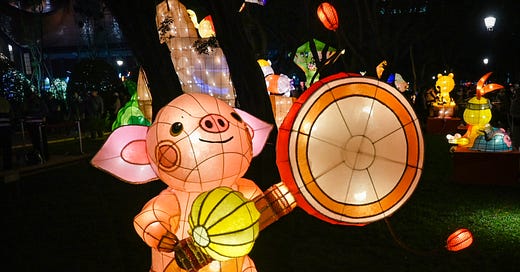The last few weeks have been a flurry of grant-writing, so I’ve spent a lot of time bonding with my long-neglected couch while I frame and reframe my work for the various granting agencies upon whose largesse I, like all researchers, rely.
Thus, I can only consider it a stroke of luck that I have, in fact, made friends here in Taiwan. You see, one of said friends (hi, Patrick!) recently asked if I had made it to the Taiwan Lantern Festival. Realizing that I had not only not made it to the festival, but was in fact in danger of missing the event entirely, I ventured out to see what I could of a light arts exhibit that spanned 168 hectares and 12 neighborhoods. (Translation: I saw only a very small portion of the event.)
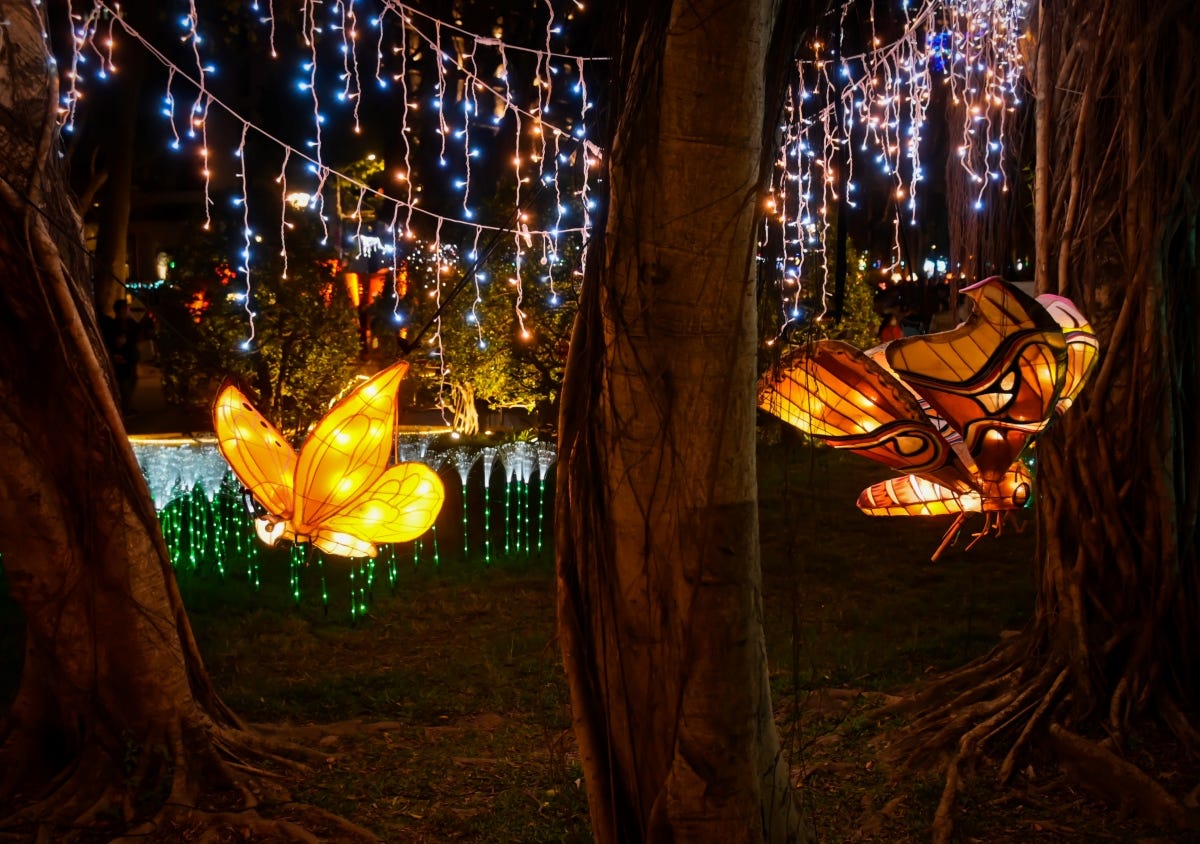
First a bit of background: For the last 34 years, the annual Taiwan Lantern Festival (TLF) has celebrated the traditional Chinese holiday of the same name. The holiday itself occurs on the first full moon of the lunar year, but the Taiwan Lantern Festival lasts for a couple of weeks. In its current incarnation, the TLF rotates host cities throughout Taiwan, meaning that this year was the first time in 23 years that it has taken place in Taipei.
Despite the fact that I ended up going to the festival on both the penultimate and closing nights of the festival, I only saw a small sampling of the hundreds of lanterns that were spread across multiple districts throughout the city. (The website offers a full English iteration, and it’s worth exploring for the pictures, if nothing else.) Even this tiny subset of lanterns, however, was a bit of an overwhelming experience. See, these are not the modest, everyday lanterns you see adorning restaurants and businesses throughout Taiwan. No, this is an event where thousands of people came to experience the brightly-colored, sometimes-animatronic lanterns built on the scale of Disney theme park rides.

The lanterns ranged from abstractly artistic installations to nakedly commercial endeavors, with iconography that encompassed everything from traditional Chinese dragons to futuristic space bunnies (the latter of which, I regret to report, frequently looked ready to do some damage to your 2023). Meanwhile, the creators and sponsors of the lanterns represented a broad swath of interested parties, from independent artists to professional organizations, families to schools, cities to nations (more on that in a bit).
The lanterns themselves were beautiful. In fact, there were some parts of the main display area that were pure magic. But, given who I am and the nature of my research interests, I am also interested in all of the non-lights activities that surround the festival. In particular, I am fascinated by the performances at the TLF’s opening and closing ceremonies, as well as the government sponsored videos that laid out a rationale for the huge expenditure of time, talent, and treasure that went into making possible this herculean undertaking. In the end, I am struck by the hopefulness of the organizers’ future-oriented rhetoric, as well as their willingness to use multimedia resources to play very openly on the emotions of viewers. In this way, I find there to be striking similarities between government media productions for Taiwan’s National Day, and those featured at the TLF.
Before we get into all of that, however, let’s talk about some lanterns!
Taiwan, the Light-up Island
The main display area of the festival was centered on the Sun Yat-Sen Memorial Hall, an area in Eastern Taipei that happens to be conveniently close to the Songshan Creative and Cultural Park, which served as one of the secondary venues, and Taipei 101, which got in on the action by turning the façade of the skyscraper into its own animated lights display. Even the streets around and between the display areas were festooned with lanterns, both providing guided pathways between the exhibit’s many zones, and acting as installations in their own right.
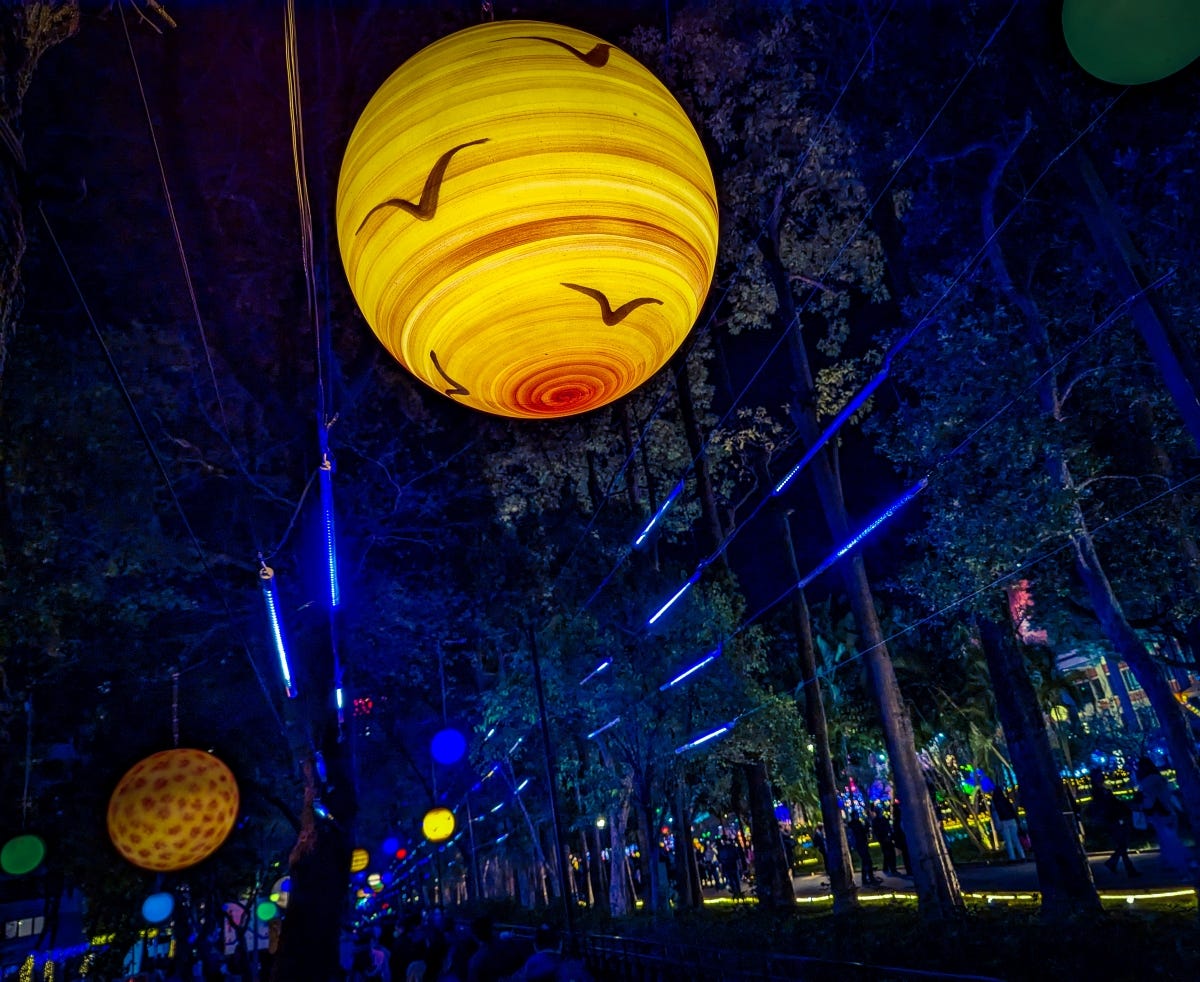
The TLF’s introduction to its theme, “Light up the Future,” explains, “The festival lights up the future, combining tradition with the future, showcasing the most futuristic light arts. Offering the most profound cultural experience, the city of Taipei continues to radiate light and energy under the night sky.” While this is admittedly a rather broad aesthetic umbrella, the festival’s different display zones did a good job of creating thematically consistent areas that made it possible to appreciate like alongside like.
Many of the lanterns were what you might expect from a festival based on the traditional East Asian lunar calendar. Rabbits abounded, of course—we are in the Year of the Rabbit, after all—but other members of the Chinese zodiac were not to be left out, with tributes to monkeys, pigs, tigers, snakes, and the rest of the gang scattered throughout the display area.

The family-friendly main display zone, with its smiling, cartoonishly anthropomorphic subjects, was by far the most crowded area that I visited. And although parents strolling through this area may have justified braving the crowds by reasoning that the kids would love it, the individuals I most frequently saw leaping out in front of lanterns to pose for selfies were the parents and grandparents of the multigenerational families in attendance.
Elsewhere, a water installation made for a more contemplative atmosphere, with artful lighting of the surrounding flora turning the entire space into a somewhat fantastical vista, all of which was reflected in the pond. The change in atmosphere in this area was probably partly the result of the pond, which unavoidably created a sense of greater space and openness than was found in the landlocked, family-focused section of the festival. But the displays ringing the pond also may have played a part in the atmosphere of (relative) calm. In contrast to both the gem tones of the installations in the middle of the pond, and the saturated primary colors of the main exhibit’s rabbits, lions, and monkeys, many of the installations around the pond were made of natural-looking materials, or were monochrome wire-based structures in which brightly bulbs created highlights, rather than acting as the main attraction.
Away from the main display area, several of the displays took on a more futuristic and/or interactive character. Here, abstract lighting displays straight out of a sci-fi movie, or touch-sensitive colored floor tiles reminiscent of the pixelated video game art of the 1980s leaned strongly into Taiwan’s semiconductor dominance, and provided the opportunity for equal parts creative interaction and adorableness.
If all of this sounds like a lot, well, I already told you that the experience of attending frequently felt overwhelming. But this doesn’t mean that the layout was chaotic, or that there was no clear hierarchy to the hundreds of creations on display.
The center square of the festival area included the TLF’s two main attractions. The first was the brightly hued Taiwan blue magpie pictured toward the beginning of this post. (I confess I didn’t know that it was a magpie—I initially mistook it for the Mikado pheasant that adorns Taiwan’s $1,000 bill). Upon drawing closer, it became apparent that the magpie’s plinth was constructed in the shape of Taiwan, and also included a nest of magpie chicks, along with a magpie parent keeping guard over the nestlings. (Given that the magpie in flight and the magpie guarding over the chicks were not visually differentiated from one another, I’ll confess a bit of confusion as to why the artist’s explanation of this installation required quite such a patriarchally normative vision of the family, but I digress.)
But there was one undisputed centerpiece of the TLF, namely, a towering space bunny on a rotating plinth, complete with a digital face (modeled on motion-capture images of the facial expressions of Taiwanese Olympic gold medalist weightlifter Kuo Hsing-Chun 郭婞淳) that blinked out from behind its visor. At regular intervals, said space bunny would play a song and launch into a lights show. This performance was accompanied by a soundtrack written by Golden Melody Award-winner Chen Chien Chi 陳建騏, whose composition at first hovered somewhere between the effervescent bubblegum pop stylings of vocaloids like Hatsune Miku and upbeat video game soundtracks of the Mario Party genus, before moving into a section evoking more traditional cultural signifiers like the dizi (bamboo flute) and suona (a raucously festive double reed instrument with a wooden bore and a metal bell).
In the explanation of the lantern (really more like a 22-meter-tall lapine robot) on the TLF website, the artist explains, “The Jade Hare ‘robot’ lantern … allows us to reflect not only on Taiwan's technological growth, but also its progress and achievements in areas such as democracy, freedom and international participation. As the Year of the Rabbit begins, everyone is ready for a new start … Thus, the lantern also conveys the theme that Taiwan will continue to shine as a beacon of freedom to the world.”
In the midst of all the color and bustle of the TLF, I am struck by the clarity with which statements like this articulate a vision of Taiwanese identity that seems aimed at an international audience just as much as it is at the domestic Taiwanese audience. And despite the fact that there are no direct claims of Taiwanese independence made anywhere in TLF materials, statements like “Taiwan will continue to shine as a beacon of freedom to the world” certainly create an association-by-proximity between the concepts of “freedom” and “Taiwan.”
Despite this aspirational messaging, however, there were sections of the festival that raised some question for me.
Shadows at the Taiwan Lantern Festival
The TLF acknowledged in many places that this year’s festival took place in the context of (or, in some framings, the immediate aftermath of) the global pandemic. Thus, it is maybe unsurprising that reminders of the pandemic crept into the displays at the TLF. It is also perhaps unsurprising that these were not the most centrally located, to the point that my attempts to locate specific pandemic-themed lanterns were thwarted by staff at info booths, all of whom very confidently sent me charging off in various directions, none of which led to the floats I was seeking.
But there is another shadow of a question that emerges in the midst of the TLF’s brightly lit displays. You see, in addition to the professionally produced and commissioned pieces, there was also a “competition” category. This competition category was further divided into several categories, including the Family, Junior High, Senior High, University/Member of Society, and the (apparently euphemistically named) Organization/Institution Group. This latter group included over 90 entries produced by prisoners in jails throughout Taiwan. (The fact that the artists are prisoners is never explicitly stated, but blanked-out middle characters of every artist’s name points to the legal status of the artists, along with the fact that the sponsoring organizations for these lanterns were all prisons.)
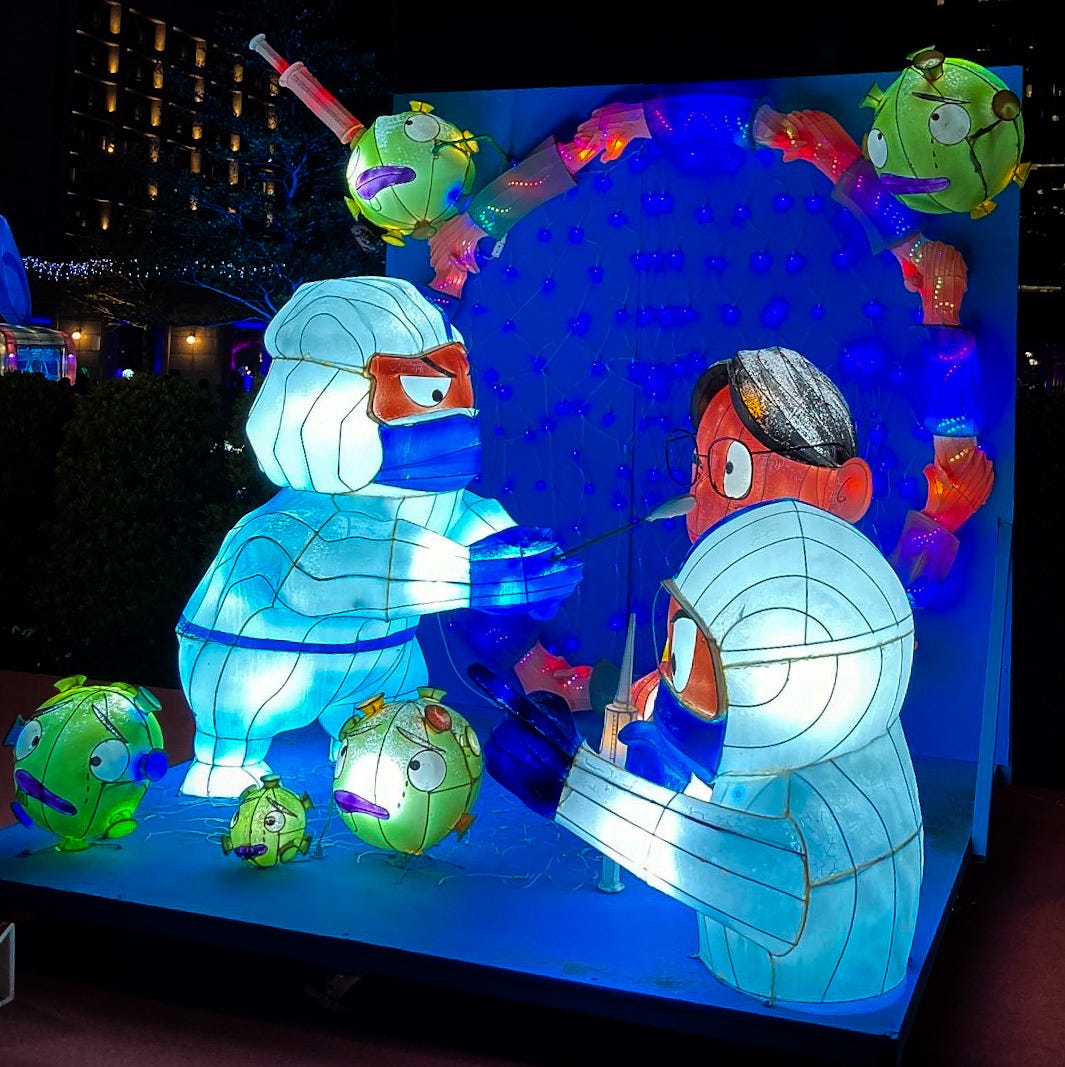
Many of the lanterns produced in this category were quite spectacular examples of the kinds of family-friendly fare that was offered up in the main display center. But there was a subset that played to darker themes. A rabbit judge with what can only be called a Grinchy sneer. A machine gun-wielding rabbit, whose explanation as an expression of “gratitude for the hard work of the military, and to cheer them on” only slightly ameliorates the sinister aura created by the glowing red hills over which “Superrabbit” stands guard. A group of anti-epidemic workers diligently combatting COVID, but whose hazmat suits cannot help but call to mind the once revered, now reviled “big whites” 大白 of Mainland China’s abandoned zero-COVID policy. And many references to anti-COVID medicines, divine protection, and giant syringes.
Maybe it’s natural that, 10 months after the government’s decision to allow COVID to run through Taiwan, many lanterns would focus on the experience of the epidemic. But it’s worth considering that, from what I can see from the comprehensive listing of lanterns on the festival’s website, the lanterns by incarcerated people are the only ones that regularly deal with Taiwan’s anti-epidemic controls, or that offer up depictions of members of the justice system and military.
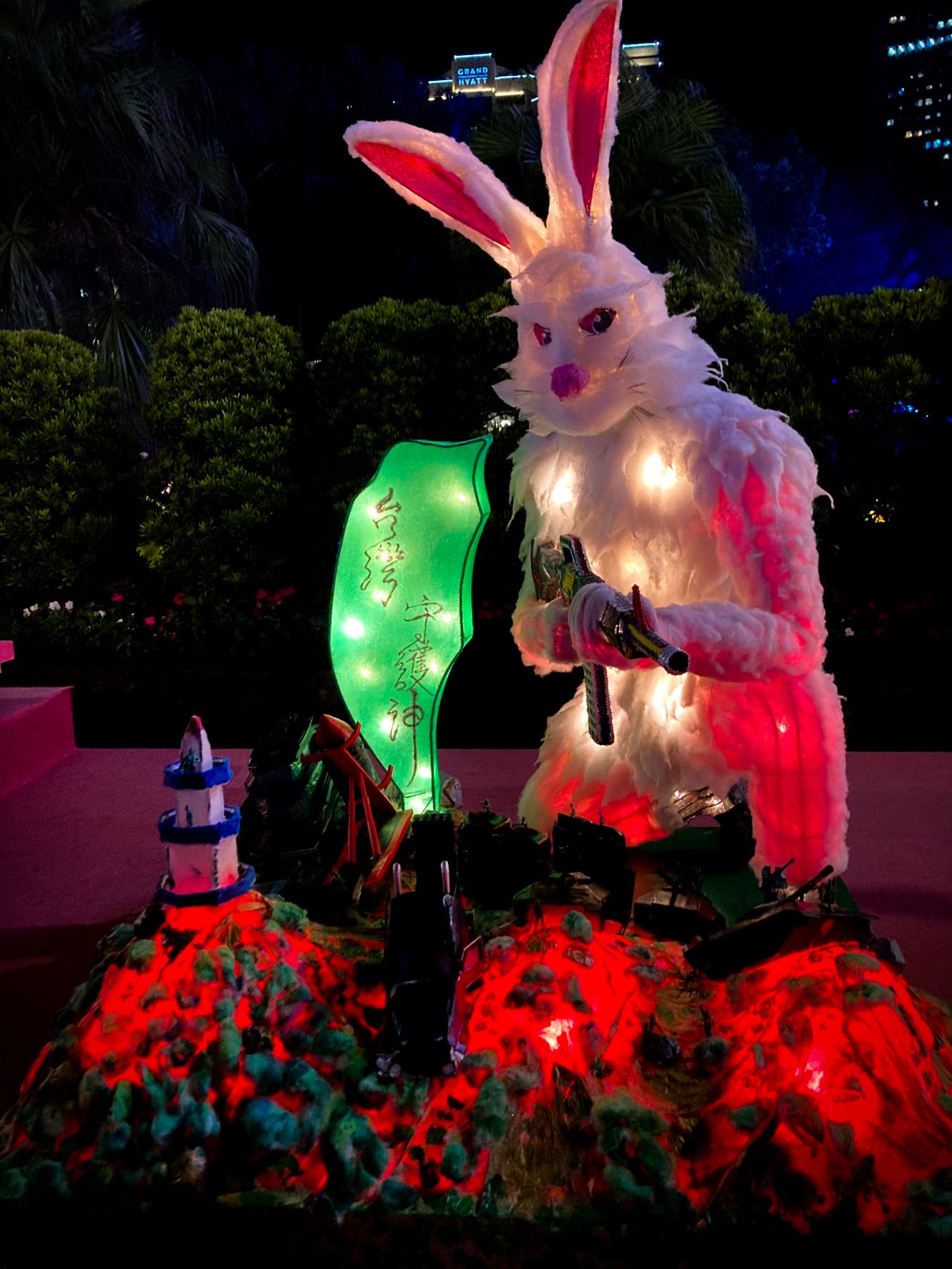
No further information is given on the terms by which prisoners worked on these lanterns. However, given that prisoners in many areas of the world have been much more vulnerable to COVID infection and mortality, these hard-to-find lanterns draw attention—sometimes subtly, sometimes less so—to the social pressures and realities facing Taiwan’s incarcerated population.
“We Are Ready to Welcome the World”
In a government-produced video played at the closing ceremony of the TLF, the text on screen proclaims, “We are ready to welcome the world to Taipei and Taiwan.” And it’s true, many parts of the festival point to the ways that the TLF is not merely for the benefit of local residents, but also provides opportunities for engagement with a global audience.
For example, an entire section of the main display area was given over to installations promoting international friendship and tourism by provincial and national governments from places as far-flung as South Korea, Guam, and Belize, and from over a dozen prefectural, regional, and corporate sponsors in Japan.
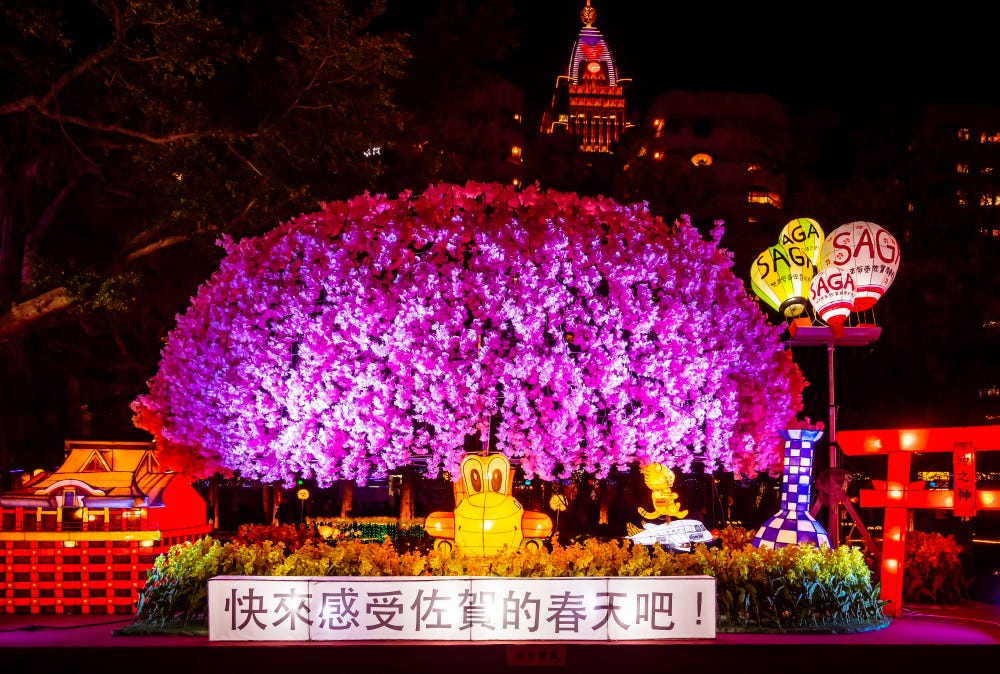
The opening and closing ceremonies were also opportunities for engagement with international audiences. Dance troupes, marching bands, and other performers were brought from France, Spain, and Japan, while the Taiwanese groups that performed presented a program that carefully balanced traditional and contemporary arts, professional and amateur organizations, Han and aboriginal performers. (This program could itself be the subject of an entire dissertation. For that matter, so could the stunning 20-minute choral set by the Atayal choir.)
But ultimately, I think there’s more at work here than just a single carefully planned performance to close the festival, or a pithy video produced by a government agency or two. Rather, when I take the closing ceremony of the TLF in aggregate with other large-scale events I’ve attended, such as the National Day Light Projection Show, it also starts to suggest recurring themes in the current government’s strategy of presenting Taiwan to both domestic and international audiences.

For example, light isn’t simply a given artistic medium of the TLF. It also functions as a motif for Taiwanese identity, seen at both the TLF and National Day celebrations. The TLF says, “Taiwan has emerged stronger, more resilient, and more robust. The festival showcases the lights of Taiwan to the world, strengthening the bonds between us, and telling stories about the city and its people … The city of Taipei continues to radiate light and energy under the night sky.” Statements like this slip subtly between the idea of the actual light given off by the lanterns, and the metaphorical idea of the beacon, the light in the night, the glimmer of hope for the future. But they also call to mind other government productions, like this statement from the introduction to the National Day Lights Projection Show:
“We collectively are energized by the coalescence of democracy and freedom … Love embraces Taiwan, the Island of Light … The force of creativity, deep-rooted in the island of Taiwan, is the source enriching our lives and culture. Surviving the trials of time, it continues to shine onto our future. Together, we pass on this love embracing Taiwan. Together, we become that island of light, for you and me.”
In both cases, the films produced by government agencies cleverly use music as an emotional stimulus to up the affective ante of their pieces. Whether it’s a Lisztian Liebestraum, a lushly neoromantic confection with sustained brass, single-voiced piano melodies, and syncopated strings that hit squarely in the center of what musicologist Berthold Hoeckner calls “the bittersweet spot,” or the slow swell of a Taiyu song sung by an all-star cast of Taiwanese pop musicians, these productions don’t simply repeat the same textual themes over and over again. They also continually strike similar emotional notes, working to build emotional associations around narratives of Taiwanese nationhood.

Through these kinds of repeating, mutually reinforcing statements and strategies, a picture starts to come into view of what Taiwan is, or claims to be, or aspires to be—or at least, the current government’s wish list. Creative, loving, global, future-oriented, democratic, a defender of freedom (although whose freedom is the part doesn’t get said out loud). It is in large-scale events like the TLF and National Day presentations that the government has the opportunity to repeat its message on a vast scale. But it is also through events like these that we can see how critics, cultural commentators, and attendees respond to certain kinds of messaging. In short, it is in events like these that we have the opportunity to catch glimpses of—or hear snippets of—the kinds of processes that I’m referring to whenever I harp on about “contests over national identity.”

